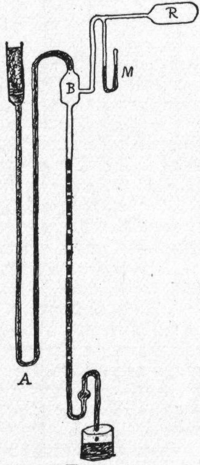
Sprengel pump
Encyclopedia

Vacuum pump
A vacuum pump is a device that removes gas molecules from a sealed volume in order to leave behind a partial vacuum. The first vacuum pump was invented in 1650 by Otto von Guericke.- Types :Pumps can be broadly categorized according to three techniques:...
invented by Hanover
Hanover
Hanover or Hannover, on the river Leine, is the capital of the federal state of Lower Saxony , Germany and was once by personal union the family seat of the Hanoverian Kings of Great Britain, under their title as the dukes of Brunswick-Lüneburg...
-born chemist
Chemist
A chemist is a scientist trained in the study of chemistry. Chemists study the composition of matter and its properties such as density and acidity. Chemists carefully describe the properties they study in terms of quantities, with detail on the level of molecules and their component atoms...
Hermann Sprengel
Hermann Sprengel
Hermann Sprengel FRS was a German chemist who discovered the explosive nature of picric acid in 1873. He also invented a generic class of materials called Sprengel explosives...
in 1865 while he was working in London
London
London is the capital city of :England and the :United Kingdom, the largest metropolitan area in the United Kingdom, and the largest urban zone in the European Union by most measures. Located on the River Thames, London has been a major settlement for two millennia, its history going back to its...
. The pump created the highest vacuum
Vacuum
In everyday usage, vacuum is a volume of space that is essentially empty of matter, such that its gaseous pressure is much less than atmospheric pressure. The word comes from the Latin term for "empty". A perfect vacuum would be one with no particles in it at all, which is impossible to achieve in...
achievable at that time.
The system used drops of mercury
Mercury (element)
Mercury is a chemical element with the symbol Hg and atomic number 80. It is also known as quicksilver or hydrargyrum...
falling through a small-bore capillary tube to trap air from the system to be evacuated. The falling mercury drops compressed the air to atmospheric pressure which was released when the stream reached a container at the bottom of the tube. As the pressure dropped, the cushioning effect of trapped air between the droplets diminished, so a hammering or knocking sound could be heard, accompanied by flashes of light within the evacuated vessel.
The speed, simplicity and efficiency of the Sprengel pump made it a popular device with experimenters. Sprengel's earliest model could evacuate a half litre vessel in 20 minutes. The device was later found capable of reducing the pressure to less than 1 mPa
Pascal (unit)
The pascal is the SI derived unit of pressure, internal pressure, stress, Young's modulus and tensile strength, named after the French mathematician, physicist, inventor, writer, and philosopher Blaise Pascal. It is a measure of force per unit area, defined as one newton per square metre...
. .
William Crookes
William Crookes
Sir William Crookes, OM, FRS was a British chemist and physicist who attended the Royal College of Chemistry, London, and worked on spectroscopy...
used the pumps in series in his studies of electric discharge
Electric discharge
Electric discharge describes any flow of electric charge through a gas, liquid or solid. Electric discharges include:*Electric glow discharge*Electric arc*Electrostatic discharge*Electric discharge in gases*Leader *Partial discharge...
s. William Ramsay
William Ramsay
Sir William Ramsay was a Scottish chemist who discovered the noble gases and received the Nobel Prize in Chemistry in 1904 "in recognition of his services in the discovery of the inert gaseous elements in air" .-Early years:Ramsay was born in Glasgow on 2...
used them to isolate the noble gas
Noble gas
The noble gases are a group of chemical elements with very similar properties: under standard conditions, they are all odorless, colorless, monatomic gases, with very low chemical reactivity...
es, and Joseph Swan
Joseph Swan
Sir Joseph Wilson Swan was a British physicist and chemist, most famous for the invention of the incandescent light bulb for which he received the first patent in 1878...
and Thomas Edison
Thomas Edison
Thomas Alva Edison was an American inventor and businessman. He developed many devices that greatly influenced life around the world, including the phonograph, the motion picture camera, and a long-lasting, practical electric light bulb. In addition, he created the world’s first industrial...
used them to evacuate their new carbon filament lamps. The Sprengel pump was the key tool which made it possible in 1879 to sufficiently exhaust the air from a light bulb so a carbon filament incandescent electric light bulb
Incandescent light bulb
The incandescent light bulb, incandescent lamp or incandescent light globe makes light by heating a metal filament wire to a high temperature until it glows. The hot filament is protected from air by a glass bulb that is filled with inert gas or evacuated. In a halogen lamp, a chemical process...
lasted long enough to be commercially practical. Sprengel himself moved on to investigating explosives and was eventually elected as a Fellow of the Royal Society.

